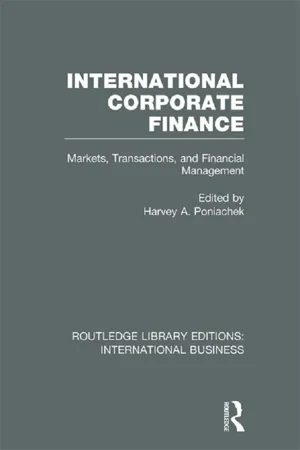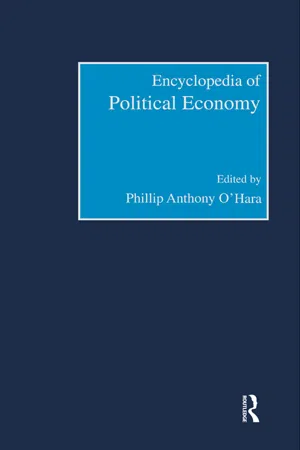Economics
International Loans
International loans refer to financial transactions where a country borrows money from foreign entities or international organizations. These loans are often used to finance development projects, infrastructure, or to address balance of payment deficits. They can be in the form of bilateral loans between two countries or multilateral loans involving multiple lenders and borrowers.
Written by Perlego with AI-assistance
Related key terms
Related key terms
1 of 4
Related key terms
1 of 3
5 Key excerpts on "International Loans"
- eBook - ePub
International Corporate Finance (RLE International Business)
Markets, Transactions and Financial Management
- Harvey Poniachek(Author)
- 2013(Publication Date)
- Routledge(Publisher)
In summary, the distinction between changes in official monetary reserves and international liquidity has diminished due to both intenational borrowing and also relatively easy access to, and widespread use, of the Eurocurrency market. This development has had several effects. It reduced the optimum level of reserves, diminished the link between a country's reserve position and its willingness and ability to run balance-of-payments deficits and made necessary a revision of the concept and estimation of reserve adequacy whereby access to international capital markets and use of borrowings have to be considered.International Debt
The international debt crisis since 1982 modified significantly the international financial markets and reduced the growth of sovereign syndicated lending to many LDCs. It required wide-scale rescheduling and financing negotiations between the major debtor countries and the banks under the auspices of the IMF. These agreements usually involved adjustment programs of the indebted countries, restructured loan agreements, and often the provision of new loans. More specifically, the framework of restructuring foreign debt is associated with economic policy reform, deferments of amortization payments, bridge financing, and financing modalities. The latter includes currency denomination options, onlending and relending, trade and credit facilities, cofinancing with multilateral institutions and debt conversion into bonds and equity.15The IMF has played a central role in the management of the debt crisis by assisting developing countries in the design of economic programs and by helping to mobilize the necessary financial resources in support of these programs. The Fund's strategy is based on a case-by-case approach involving coordinated efforts by debtor and creditor countries, commercial banks, and multilateral financial institutions. Creditor governments have also facilitated financial flows to developing countries through the Paris Club. The Paris Club has agreed to successive annual rescheduling in a number of cases and to multiyear rescheduling agreements. - eBook - ePub
Finance and Development
The Role Of International Commercial Banks In The Third World
- Michael DaCosta(Author)
- 2019(Publication Date)
- Routledge(Publisher)
The advantage of bank lending in foreign exchange is that it overcomes a most serious constraint to growth:- that of foreign-exchange itself, at the same time as it supplements domestic savings. In this context it is useful to note Johnson who interprets balance-of-payments deficits of LDCs in terms of an investment-savings relationship, the proper analysis of which requires the use of a general equilibrium approach which would integrate the domestic and foreign aspects of development finance. 37) In the absence of a free international capital market trading in all types of paper issued by developing countries as was the case before the collapse of the market in the Great Depression of 1929–1930, the international banks will continue to be called upon to perform the vital task of channelling savings to the poorer countries of the world. As the following Chapter shows, it is a task which they have carried out in the past to great effect. In the 1980s, they are being called upon to make a repeat performance. - eBook - ePub
Banking on the World
The Politics of American International Finance
- Jeffry Frieden(Author)
- 2015(Publication Date)
- Routledge(Publisher)
In the last twenty years, the center of industrial dynamism has moved from North America, Western Europe, and Japan to rapidly developing countries in Latin America, Asia, and Africa, and borrowing from the international financial system has dramatically speeded the process. Over a dozen newly industrializing countries borrowed on the Euromar-kets to build modern industries and flooded world markets with their manufactured products. The industrialized world now buys many of its videocassette recorders, shoes, auto parts, and clothes from the same countries that owe more than half a trillion dollars to its banks.Both aspects of developing-country debt—the underlying instability it introduces into international finance, and the major industrial development it financed—are of profound importance to the United States. The Third World debt crisis has forced banks, businesses, and government agencies in the United States to readjust their activities and their balance sheets to avoid serious domestic economic repercussions. Third World debt-financed industrialization has built a cohort of dynamic new manufacturing regions that are exerting increasing competitive pressure on American firms and workers.The $600 billion that international banks lent to developing countries is both the biggest success of the international financial system and its most serious failure. International banks transferred vast sums to countries that desperately need capital for economic growth. The borrowers invested much of the money in modern industrial projects of international importance. But when more than fifteen years of frenetic Third World bank borrowing came to an abrupt stop in 1982, the crisis shook the foundations of the financial system itself. The political and economic effects of Third World debt are still being felt.The attractions of foreign loans have long prompted developing countries to borrow abroad. International capital movements have indeed played a major role in the international expansion of capitalism from its early European base to the rest of the world. As England industrialized in the eighteenth century, it relied heavily on capital provided by the wealthy and experienced Amsterdam financial community. The same Amsterdam financiers bankrolled part of the American Revolution and the postrevolutionary reconstruction. British and Continental lending to the United States in the nineteenth century helped to finance the canal- and railroad-building booms that revolutionized the American economy. Latin American states first borrowed in Europe in the 1820s, soon after they won their independence, and they remain important international debtors. At various times countries in eastern and southern Europe and North Africa, as well as Japan, Canada, Australia, and South Africa have all relied on foreign investors for major portions of their investment financing. - eBook - ePub
The Lending Policy Of The World Bank In The 1970s
Analysis And Evaluation
- Bettina S. Hurni(Author)
- 2020(Publication Date)
- Routledge(Publisher)
The main concern must be that all capital, be it domestic or foreign, must be made as productive in the hands of the poor as in the hands of the rich. But in development theory, there are as yet no determined, objective measures that include all dimensions of poverty. Yet another practical conclusion is that poverty relief must be more an investment in human capital than in physical capital. Hence, finding a means of overcoming manpower constraints seems more instrumental to development than capital lending only, and any training instruments used to do so should lead to certain mentality changes favoring development. In the 1970s, development increasingly became an issue of international power relations, and much less of an economic issue, as the domestic power relations inside each developing country, and among the developing countries themselves, became much more important than development lending. But power politics also remain important in the bilateral relations between industrialized and developing countries. On the multilateral level, that is, above bilateral politics, the World Bank is truly concerned with the economics, not the politics, of development. It insists that its lending is yielding satisfactory financial, economic, and social rates of return. It has a fragmented, but genuinely collective, decision-making process as a bridge-building element. It lends to socialist and capitalist countries alike and can show success under both of these different social systems. It has helped countries to move from a debtor to a creditor position. It lends to the very poorest, to the middle-income, and to the richer countries of the developing world, also with successes in all three different groups of countries. It lends to the private and the public sectors of its borrowers. Its practical, apolitical lending policy has eased certain postwar tensions between former enemies, as a large reconstruction project in Vietnam and massive economic aid for Egypt exemplify - eBook - ePub
Encyclopedia of Political Economy
2-volume set
- Phillip O'Hara(Author)
- 1999(Publication Date)
- Routledge(Publisher)
The aid effectiveness debate has also addressed the issue of aid’s impact on poverty. Although poverty alleviation is frequently cited as a major motivation for aid, it is in fact difficult to say how much aid is directly used to help the poor; though it is likely that 15–20 percent is a generous estimate. We have even less evidence on how the poor have benefited from most aid transfers, but there are a number of biases in aid programs that have limited their effectiveness in this regard. Commentators on aid from across the spectrum agree that it is subject to political and commercial pressures in the donor country. These pressures affect which countries receive aid (Israel and Egypt are major beneficiaries of US aid) and what types of project they finance (donors are keener to fund high-tech urban roads than rural feeder roads built using labor-intensive techniques). Moreover, donor credibility in encouraging governments to target the poor is undermined when donors themselves use aid for other purposes.ConclusionIncreasing the poverty impact of aid remains one of the major challenges for research and practice. Others argue that there is a need to reinvent international cooperation beyond aid, and to find new ways of ensuring international security in the post-Cold War era. Nonetheless, it is likely that aid flows will remain an important feature of the international economic system for some time to come, especially in relation to the poorer countries of the world.See also: debt crises in the Third World; inequality Selected referencesBauer, Peter (1991) The Development Frontier: Essays in Applied Economics, Brighton: Harvester Wheatsheaf.Chenery, Hollis B. and Strout, Alan M. (1966) “Foreign Assistance and Economic Development,” American Economic Review 56(4): 679–733.Griffin, Keith (1970) “Foreign Capital, Domestic Savings and Economic Development,” Bulletin of the Oxford University Institute of Economics and Statistics 32(2): 99–112.Hayter, Teresa and Watson, Catherine (1985) Aid: Rhetoric and Reality, London: Pluto Press.Mosley, Paul (1987) Overseas Aid: Its Defence and Reform, Brighton: Wheatsheaf.White, Howard (ed.) (1997) Aid and Macroeconomic Performance: Theory, Empirical Evidence and Four Country Cases, London: Macmillan.HOWARD WHITE foreign direct investmentForeign direct investment (FDI) denotes the export of productive, non-loan capital from one country to another. It includes, therefore, capital exports for the establishment of subsidiary or joint venture companies, for company mergers and so on, and is related to the formation of TRANSNATIONAL CORPORATIONS. FDI is usually identified by ownership of at least 10 percent of the equity in an enterprise, and it covers claims that are intended to remain outstanding for more than one year. Loans between an associated company or subsidiary and a mother company are in most cases considered by international statistics to be FDI. FDI constitutes one of the major components of the capital accounts of a nation’s balance of payments.
Index pages curate the most relevant extracts from our library of academic textbooks. They’ve been created using an in-house natural language model (NLM), each adding context and meaning to key research topics.
Explore more topic indexes
Explore more topic indexes
1 of 6
Explore more topic indexes
1 of 4




